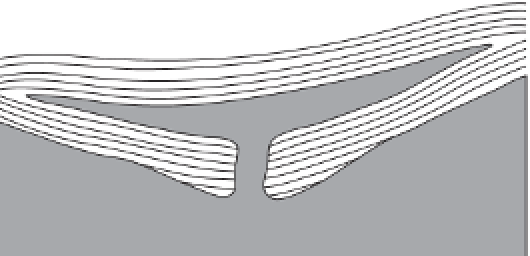Geology Reference
In-Depth Information
the ocean's surface. The island was named after the giant of fire in Icelandic mythology. Surtsey is about 1.5 km
in diameter with an area of 2.8 km
2
. Between 1967 and 1991, Surtsey subsided about 1.1 m (Moore
et al
. 1992),
probably because the volcanic material compacted, the sea-floor sediments under the volcano compacted, and possibly
because the lithosphere was pushed downwards by the weight of the volcano. Today, the highest point on Surtsey is
174 m above sea level.
Batholiths and lopoliths
VOLCANIC AND PLUTONIC
LANDFORMS
The larger intrusions - batholiths, lopoliths, and stocks -
are roughly circular or oval in plan and have a surface
exposure of over 100 km
2
(Figure 5.1). They tend to be
deep-seated and are usually composed of coarse-grained
plutonic rocks.
Batholiths
, also called
bosses
or
plutons
(Figure 5.1a),
are often granitic in composition. The granite rises to
the surface over millions of years through diapirs, that is,
hot plumes of rock ascending through cooler and denser
country rock. Enormous granite batholiths often under-
lie and support the most elevated sections of continental-
margin orogens, as in the Andes. Mount Kinabalu,
which at 4,101 m is the highest mountain in South-
East Asia, was formed 1.5 million years ago by the
intrusion of an adamellite (granitic) pluton into the
surrounding Tertiary sediments. Batholiths may cause
a doming of sediments and the ground surface. This
has occurred in the Wicklow Mountains, Ireland, where
the Leinster granite has led to the doming of the over-
lying Lower Palaeozoic strata. Once erosion exposes
granite batholiths, weathering penetrates the joints.
Magma may be extruded on to the Earth's surface or
intruded into country rock, which is an existing rock into
which a new rock is introduced or found. Lava extruded
from volcanic vents may build landforms directly. On the
other hand, lava could be buried beneath sediments, be
re-exposed by erosion at a later date, and then influence
landform development. Intruded rocks, which must be
mobile but not necessarily molten, may have a direct
effect on landforms by causing doming of the surface,
but otherwise they do not create landforms until they
are exposed by erosion.
Intrusions
Intrusions form where molten and mobile igneous rocks
cool and solidify without breaching the ground surface
to form a volcano. They are said to be active when they
force a space in rocks for themselves, and passive when
they fill already existing spaces in rocks.
()Batholith
a
( ) Lopolith
b
Roof
pendants
Stocks
Figure 5.1
Major intrusions. (a) Batholith with stocks and roof pendants. (b) Lopolith.
Source:
Adapted from Sparks (1971, 68, 90)







